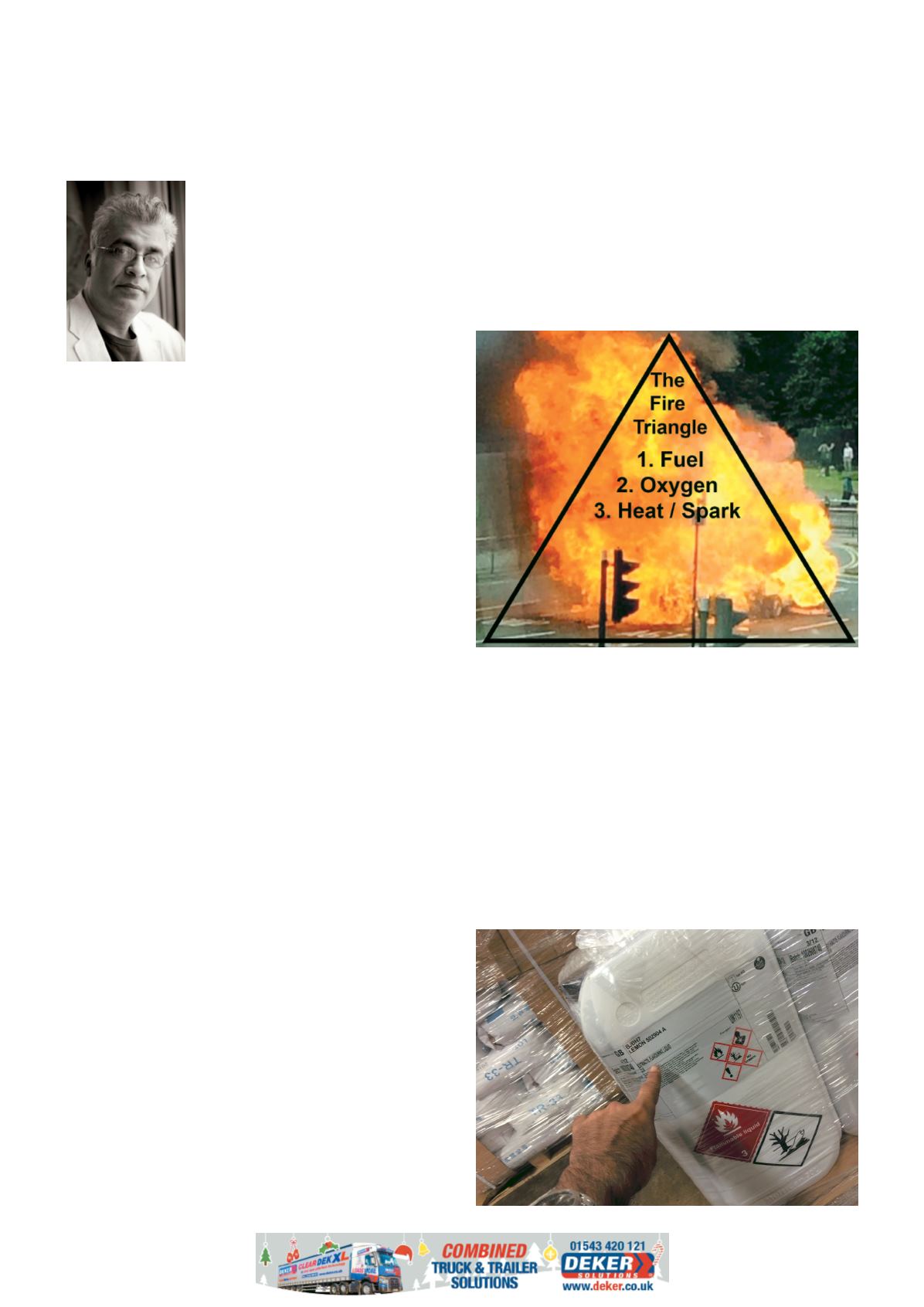

Truck and Track
Winter 2018
www.truckandtrack.com62
DANGEROUS GOODS
Last year, as Managing Director of
Hazchem Network, I came to review
the preceding 12 months activity with
our Dangerous Goods Safety Advisor
[DGSA] John Newsome, for our annual audit and report.
Neither of us were surprised to see that of all Nine Classes of
Dangerous Goods as defined under ADR and IMDG regulations,
Class 3 [Flammable Liquids] represented over 40% [in terms of
tonnage shipped] of our throughput of pallets distributed by the
Hub and Spoke
nature of Hazchem Network’s Depot Infrastructure
[UK, Ireland and Mainland Europe].
It was a deja-vu moment for me, as I recall carrying out a similar
analysis on the tanker fleet I oversaw as Operations Director of
Interoute Transport Service’s Chemical Division. Again, Class 3
[Flammable Liquids] were the largest ADR class we carried in Bulk
which, in tonnage terms, was well over half of our total carrying
capacity.
When comparing other ADR Classes carried both in Bulk Tankers
as well as Packaged within Pallets / Parcels; Class 8 Corrosive
Liquids and Class 9 Environmentally Hazardous Liquids [and
Miscellaneous] make up ~ 20% each.
While the other ADR Classes, such as Gas [Class 2]; Reactive /
Flammable Solids & Dangerous when Wet products [Classes 4.1,
4.2 & 4.3]; Oxidising Agents & Organic Peroxides [Classes 5.1 & 5.2]
and Toxic Products [Classes 6.1] make up the balance of ~20%.
So
‘over the thumb’
, my experience in both Bulk as well as
Packaged Dangerous Goods Supply Chains approximates the UK
Road Network to carry the following splits of Dangerous Goods as
regulated under ADR.
Class 3 Flammable Liquids ~40%
Class 8 Corrosive Liquids ~ 20%
Class 9 Environmentally Hazardous / Miscellaneous ~20%
Classes 2, 4.1, 4.2, 4.3, 5.1, 5.2 and 6.1 make up the balance of
~20%
Due to issues related to security I have not included information
regarding the carriage of Class 1 [Explosive], Class 6.2 [Biologically
Infectious] or Class 7 [Radioactive]; besides these have specific
regulations and [apart from selected 6.2 products] can not be mix-
loaded with other ADR Classes.
AlsotonnagesofDGshippedundertheLimitedQuantityRegulations
[LQ] for retail use, such as Nail Varnish, Aerosols [such as ‘Mr Sheen’],
Oven Cleaners etc have not been included – as when shipped under
LQDerogations, theHazard Classes are not permitted to be denoted
on external carriage labelling, or manifested within the delivery
paperwork.
ADR Class 3 Flammable Liquids both in Bulk Tankers, as well as
Packaged / Palletised products [contained within IBCs, Drums and
Cans] constitute the largest tonnage of Dangerous Goods shipped
on UK Roads; but what is Class 3?
Firstly, we need to understand the term Flash Point.
The Flash Point is the lowest temperature at which vapours of a
volatile material will ignite, when given an ignition source, with
Oxygen present. If you recall ‘the fire triangle’, in order for a fire to
start, you require -
[a] A source of fuel
[b] Heat or a naked flame, or spark
[c] Oxygen
We are ignoring Pyrophoric Material such as Silicon Tetrahydride
[SiH4] which if released can catch fire without heat or a spark, due
to reactivity with atmospheric Oxygen.
The Flash Point
is often confused with –
Fire Point
[the lowest temperature at which vapour of thematerial
Flammable Liquids within the
Supply Chain
by Ali Karim
In this issue, our Dangerous Goods Columnist, Ali Karim FRSC FCILT,
looks at the issues surrounding the safe carriage of ADR Class 3
Flammable Liquids within the Dangerous Goods Supply Chain
Ali Karim
Flammable ADR food flavouring



















